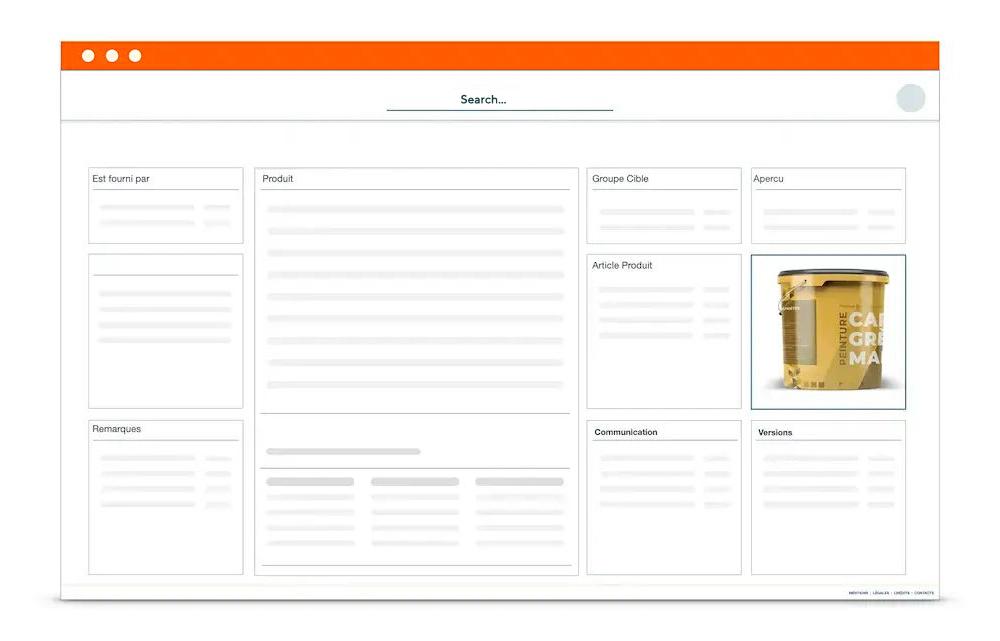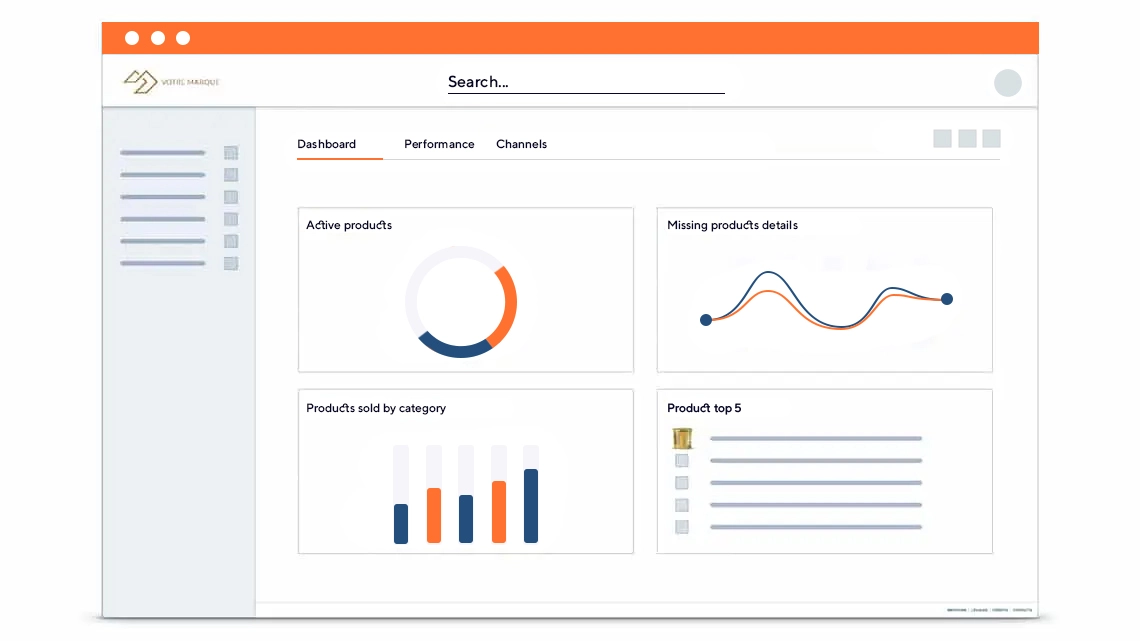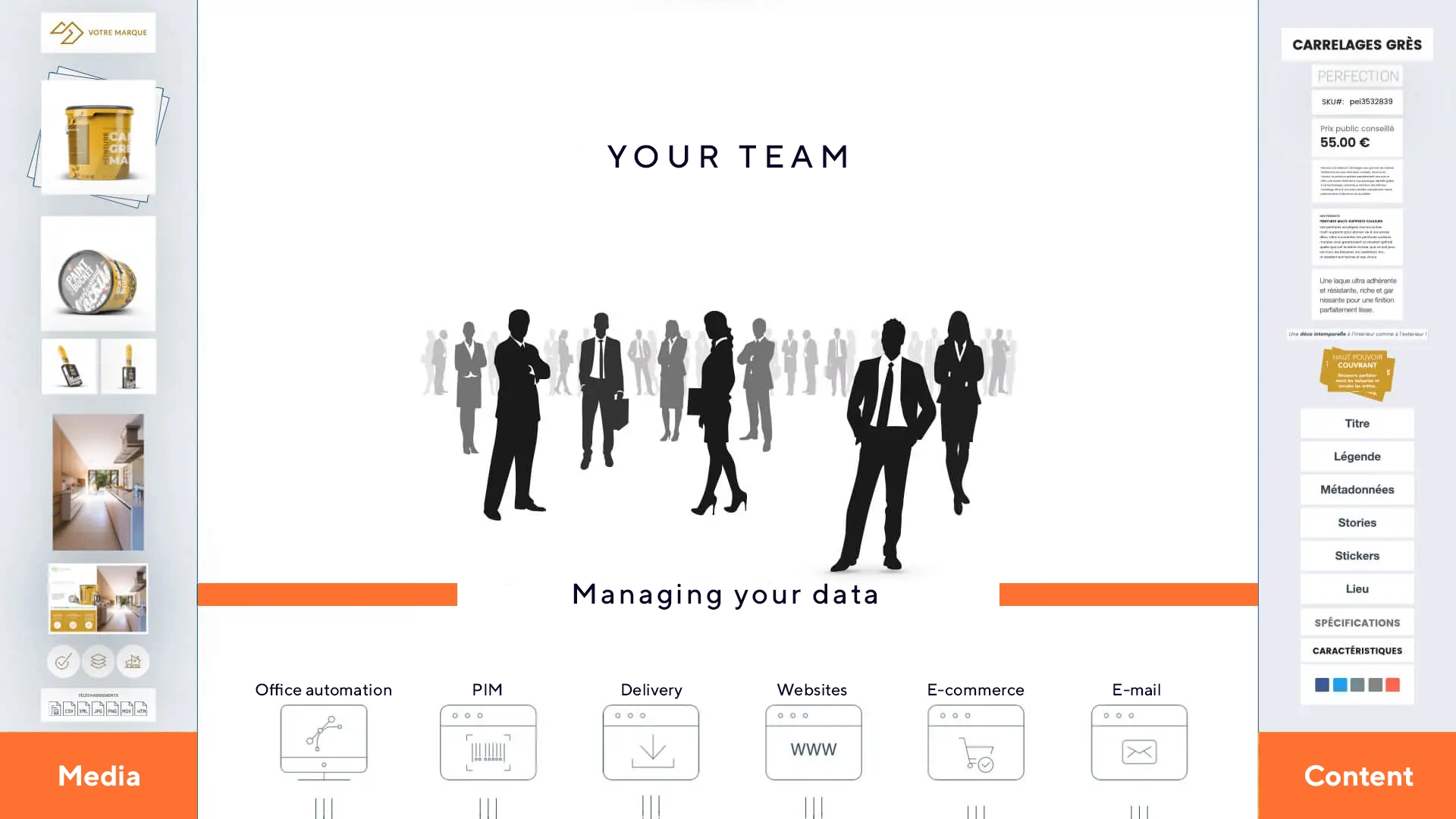PIM: what is it?


These days, you need to be on all fronts: your employees have to provide a multitude of information to various distribution and sales channels, and all at high speed!
The concept of providing the right information to the right person at the right time has never been more important.
Definition of Product Information Management
As consumers develop new habits and expectations, it’s a good idea for any business looking to improve the customer experience and boost performance to implement an effective data management solution. PIM is one of the most popular management tools. To help you understand what it’s all about, here’s the definition of Product Information Management (PIM).
Product Information Management (PIM) is a solution that coordinates the management and distribution of product information to all sales channels: e-commerce sites, websites, printed product catalogues and marketplaces.
More specifically, the PIM concentrates and harmonises all your product information while ensuring that all the content distributed is constantly updated and adapted for natural search engine optimisation (SEO). The PIM is part of the Master Data Management concept (MDM = PIM + DAM + CMS).

Why use a Product Information Management solution?
Marketing and purchasing teams are witnessing a proliferation of references and product data, a reality they have to adapt to every day. The PIM is recognised as an essential tool for data management and relationship marketing. It is the guarantee of effective management of your products on sale, in a multi-channel context.
So why use Product Information Management? What issues does PIM address?
PIM solutions: the obvious choice for e-commerce sites e-commerce
Let’s take the example of an e-commerce site specialising in the sale of trousers. The information displayed on the e-commerce shop will include: model, size, colour, material, properties, care instructions, etc. And the list goes on. There are thousands of trousers to choose from. This information is then multiplied into an extremely large number of SKU product references!
SKU stands for “Stock Keeping Unit”. These are internal product references that identify all the characteristics of your product (colour, size, etc.) and enable you to easily monitor your stocks.
If organising and manipulating data in Excel files seems to be the first solution, it turns out to be much more complex than it seems. In fact, this solution is neither fast, nor ergonomic, nor secure.
The company therefore needs to be particularly agile to ensure that the information is properly integrated into a regularly updated database. Against this backdrop, it would seem worthwhile choosing to implement product data management software for your company.
Product Information Management connects easily to your e-commerce site. It can easily associate products with numerous attributes such as dimensions, colour, material, etc. in record time. It can also clearly define links between products, cross-sell, up-sell and bundled offers. With a PIM software solution, you can finally say goodbye to Excel spreadsheets, which are a considerable waste of time for your teams.
A quick overview of the PIM process
The role of the PIM is above all to facilitate the collection of your marketing and technical information from multiple sources. It enables omnichannel organisation and distribution, and thus contributes to enriching the information visible to consumers.
The process is simple: as soon as a product is created in the company’s information system (often from the ERP), the PIM collects the raw information, centralises it and distributes it to the marketing and product teams. At this point, the work of enriching the information on the new product can begin. When the product sheet reaches the right level of quality, it is automatically distributed to the sales channels.
PXM (Product Experience Management) is an extremely important method for companies. It enables the right content to be delivered to the right person at the right time, in order to trigger a purchase. Implementing a PIM solution therefore contributes to a successful customer experience.

What are the advantages of PIM solutions?
PIM is an excellent product data management solution, particularly for maintaining a competitive edge in a constantly changing market. Here are the main benefits of Product Information Management:
- Improving the quality of your product data
- Elimination of silos, duplication and errors
- Multi-channel data distribution
- Use of reliable, up-to-date reference data
- Optimisation of time to market
- Improve customer and supplier relations
- Reduce data integration and maintenance costs
- Control of information on each distribution channel
- Increased productivity
- Production of product reports
- Improved return on investment
The benefits of Product Information Management are considerable
This software solution structures the information and keeps the database up to date, providing a quality source for the teams. As a result, the company’s various departments can use reliable and secure information at any times. Thanks to it, your employees will no longer have to spend hours working on data produced by hand! It’s a powerful automated process tool that performs time-consuming tasks for you, freeing up your teams’ time.
What are the business challenges of Product Information Management?
Managing information and its multi-channel distribution is a challenge that companies face on a daily basis. Here are the main challenges of Product Information Management:
- Making it easier to manage information across all sales channels
- Facilitating the work of teams
- Improving the customer experience
- Increasing business performance
- Securing data

Who needs a PIM solution?
From the moment you want to take control of the quality of product information distribution and strengthen relations with the various players involved in the project, the question of implementing a PIM arises. PIMs are aimed primarily at retailers and e-tailers, who have complex and extensive product catalogues. More generally, PIM can be used by :
- E-merchants: data quality is a key factor for an e-commerce business, as it has a direct impact on sales. The PIM enables e-commerce managers to modify and contextualise product information by distribution channel, country and language.
- Marketing & Communication departments: contextualising information is essential for the marketing department in order to create a 360° product experience. Communication teams, meanwhile, are looking to produce catalogues quickly and cost-effectively, with a large number of references.
- Buyers: the PIM facilitates supplier on-boarding and ensures the integrity and consistency of product information.
- IT departments: IT teams need to have structured data and know that it circulates securely.
Where does the PIM fit into the company’s ecosystem?
The PIM is capable of connecting to the entire corporate ecosystem. It is therefore an effective response to the implementation of a company’s digital strategy. Placed between the ERP, e-commerce site, web platform, marketplaces, print and points of sale, the PIM automatically distributes information across all sales channels.
How does a Product Information Management solution work?
Are you about to embark on a digital transformation in your business and wondering how PIM works? Find out how PIM works in 4 simple steps.
- Product data inventory
The first step is to collect all the data from the services and software used in the company (excel files, CRM and ERP data, supplier data, etc.). The PIM then centralises all the information in a single product repository, which can also include media, thanks to an integrated DAM.
- Product data cleansing
The recovered information needs to be cleaned up. The master file may contain duplicate references or products that are no longer stored. It is necessary to ensure the accuracy of product data in order to convey quality information to customers.
- Filling
This phase includes updating the information. This information will be broken down to follow the codes for each channel. A PIM solution contributes to the data quality process by checking that your data is complete. The PIM also has a control and validation workflow system that enables you to monitor the percentage of your product information that is complete before it is distributed.
- Information distribution
All your reliable, up-to-date information is now centralised in a single data management system. It can then be distributed to the various channels and departments involved: packaging, communications, marketing, retail, external agencies, etc.
What are the functionalities of Product Information Management solutions?
There are several PIM solutions and it is important to compare their functionalities. However, there are some features that are common to each solution:
- Centralised data management
- Integration with third-party management systems and databases
- Updating of information
- Transfer and export of product information
- Data segmentation
- Data import/export (PDF, HTML, XML, CSV etc.)
- Language management
- Product contextualisation
- Save searches
- Management of product variations
- Product experience management (PXM)
What data is managed by PIM solutions?
There are many different types of data managed by a PIM. Marketing data, media files, technical data, design data, user data, etc. PIM solutions mainly manage data and information relating to products: technical characteristics, descriptions, references, photos, parts lists, diagrams, etc.

How do you choose a Product Information Management solution?
There is no such thing as a universal Product Information Management solution. A PIM solution simply has to reflect your company’s image, because this type of tool offers a wide range of functions. You should choose your PIM solution implementation provider according to your company’s needs and your long-term ambitions.
It’s important to remember that the effectiveness and performance of the PIM are closely linked to the company’s investment upstream of the project. The ideal solution is to work with a service provider who will be able to integrate into your ecosystem and give you recommendations for restructuring your data.
You should also provide the supplier with as many elements as possible from the outset, as this is what will enable you to put in place a complete, high-quality PIM system. The relationship between the supplier and your company should be a true partnership.
Some suppliers offer solutions that are more or less adapted to the size of the company, with different functionalities. You can also choose a PLM solution to complement your PIM. This combination gives you a more global view of the product innovation cycle.
Key point: MDM (Master Data Management) encompasses PIM and DAM solutions. With this comprehensive data management system, once your information has been processed, it can be transferred to the PIM, where it is centralised and then aggregated before being shared across the various sales channels.
How can a PIM project be a success?
The introduction of a PIM is most often part of a company’s digital transformation. Generally speaking, this brand-new project will result in an upheaval in internal practices, and will sometimes turn your staff upside down as they discover a new working environment. It needs to be seen as a genuine corporate project, and requires the involvement of several departments. In other words, the project needs to be as tightly focused as possible in order to define the ideal PIM solution for your business. So here are a few tips you need to follow to make your PIM project a success:
- Review the limitations of your current Information System.
- Clearly define the expectations of the different channels and services.
- Define upstream a data dictionary and the enhancements to be made.
- Ask yourself which functionalities are necessary today, but also which will be useful tomorrow.
- Pre-select a group of solutions that you have identified and that meet your specifications. Ideally, you should keep to just 3 service providers.
- Ask yourself the question of hosting the PIM solution.
- Pay attention to the quality of the supplier’s customer service (in French at best), follow-up and support.
The PIM solution is a long-term investment for your company that will quickly be appreciated by your various employees. You should therefore capitalise on the design phase, which is the most important. After all, it would be a shame if, once integrated, the platform failed to meet operational requirements or proved ineffective on a day-to-day basis.
Are you hesitating between a PIM (Product Information Management) solution and a DAM (Digital Asset Management) solution? We can help you choose the best option for your infrastructure. Let our experts guide you through the digital transformation of your business and the deployment of a PIM!
Do you need help to define the scope of your PIM project? Ask our experts!


